#lightning tutorial salesforce
Explore tagged Tumblr posts
Text
The Salesforce Lightning Tutorial for Beginners is a comprehensive guide designed to help individuals with little to no experience in Salesforce understand and utilize the Lightning framework effectively. Salesforce Lightning is a powerful user interface (UI) framework that enables users to create dynamic, responsive, and visually appealing applications on the Salesforce platform. This tutorial aims to provide a step-by-step approach to mastering the fundamentals of Salesforce Lightning, allowing beginners to build their expertise and harness the full potential of the platform.
0 notes
Text
Can a Manual Tester Become a Salesforce Developer? Absolutely. Here's How.
Ever found yourself knee-deep in manual testing and wondering, "What if I could build the stuff I'm testing?" Well, good news: you totally can. Transitioning from manual testing to becoming a Salesforce Developer is not just possible—it might be one of the smartest career moves you can make. Especially if you're already exploring tools like Provar, a Salesforce automation tool that bridges the gap between testers and developers.
In this post, we’ll break down how you can shift gears from manual testing to Salesforce development, the skills you'll need, and how tools like Provar can help along the way.
Why Consider the Switch?
Manual testing is a great entry point into the tech world. You've got the analytical mindset, the attention to detail, and the experience working with systems. But let’s be real: it can feel repetitive, and there's often a ceiling in terms of growth.
Salesforce Development, on the other hand, opens the door to:
Higher salaries and better job stability
Creative problem-solving using Apex (Salesforce's programming language)
More influence in the SDLC (Software Development Life Cycle)
Remote-friendly work opportunities
So if you’re already familiar with how Salesforce apps should behave, you're halfway there.
What Do Salesforce Developers Actually Do?
Salesforce Developers create custom functionality on the Salesforce platform using tools like Apex (similar to Java), Visualforce (for UI), and Lightning Components (modern UI framework). They build things like:
Custom apps and workflows
Automated business processes
Integrations with other systems (like Slack, Gmail, etc.)
This means turning business needs into working features—something manual testers are already good at analyzing.
Skills You Already Have (and How They Translate)
If you’re coming from a manual testing background, you already have some golden skills that will make your move into Salesforce development a whole lot easier.
Understanding of Test Cases: You know how to think through different scenarios and outcomes. This will help you write smarter, more accurate logic and validations when you start coding.
System Thinking: As a tester, you’re already used to seeing the bigger picture and how parts of a system interact. This skill is crucial for designing scalable, efficient solutions as a developer.
Bug Reporting: You’ve spent a lot of time identifying and documenting bugs. That attention to detail translates directly into writing cleaner, error-free code.
Familiarity with Salesforce UI: If you've tested Salesforce apps before, you already have a head start! Knowing your way around the Salesforce interface gives you a solid foundation for building apps, especially when working with Lightning components.
Skills You Need to Pick Up
Don’t worry—you don’t need a Computer Science degree to become a Salesforce Developer. Here's what you'll want to learn:
Apex: Salesforce's proprietary Java-like language
SOQL: Salesforce Object Query Language for database operations
Lightning Web Components: For building responsive UIs
Salesforce Admin Skills: Understand objects, fields, workflows, etc.
Pro tip: Use Provar to bridge the knowledge gap. Since Provar automates testing within Salesforce, it helps manual testers learn about object relationships, workflows, and backend logic organically. It’s like learning to swim while already floating.
Suggested Learning Path
Let’s break it down step-by-step:
Get Certified as a Salesforce Administrator
Understand the basics: objects, fields, workflows, validation rules
Tools: Trailhead (Salesforce’s free learning hub)
Start Learning Apex and SOQL
Use Trailhead modules or YouTube tutorials
Play around in a free Salesforce Developer Org
Build Mini Projects
Try creating a custom app or automating a simple process
Document what you build—this is gold for your portfolio
Work with Provar or Similar Tools
Provar helps you understand how automation integrates with development
Try writing tests while experimenting with backend configurations
Contribute to Open Source or Freelance
Try doing small gigs or helping nonprofits
These experiences build confidence fast
Real Talk: Common Roadblocks (and How to Overcome Them)
"I don’t have a coding background."
That’s okay! Apex is beginner-friendly and well-documented. Start slow and build consistently.
"I’m afraid of making the leap."
Think of this as a skill expansion, not a total restart. You can even start by becoming a Salesforce Test Automation Engineer using Provar, and grow from there.
"Will employers take me seriously?"
Absolutely, especially if you have a strong testing background. Add some Trailhead badges and a few project demos, and you're in the game.
Why Provar Can Be Your Secret Weapon?
Provar is not just for testers. It’s also a great way to:
Understand how test automation works under the hood
Get exposure to Salesforce objects, workflows, and APIs
Bridge the tester-to-developer knowledge gap
As someone already familiar with Salesforce Testing, you can use Provar to:
Write functional test scripts and see how they map to backend logic
Experiment with edge cases and error handling (just like developers do)
Collaborate more effectively with dev teams
So yeah, Provar isn’t just a tool—it’s your training ground.
Career Growth Opportunities
Once you transition to Salesforce Development, you can branch out into:
Salesforce Architect
Technical Consultant
Product Manager (with technical chops!)
Lead Developer or Team Lead
And since Salesforce is huge across industries, you'll find opportunities in finance, healthcare, education, and tech.
Final Thoughts: Start Where You Are
Switching from manual testing to Salesforce Development isn’t just a dream—it’s a plan. With the right mindset, consistent learning, and the help of tools like Provar, you're already on your way. Don’t wait to be "ready." Start exploring, tinkering, and learning today.
Remember, your background in Salesforce Testing already gives you a leg up. All that’s left is to write some code, build something cool, and show the world what you can do.
Thinking about where to begin? Fire up Trailhead, launch a dev org, and automate your first test in Provar. You're not just testing anymore—you're building the future of Salesforce.
Ready to make the jump? We at Provar are cheering you on.
#can a manual tester become salesforce developer#salesforce developer#salesforce testing#provar#salesforce blog
0 notes
Text
The Future of Salesforce Learning: Why Online Courses are Key
Salesforce, the global leader in customer relationship management (CRM) solutions, has revolutionized how businesses manage customer interactions and data. With its growing adoption across industries, the demand for skilled Salesforce professionals is skyrocketing. For those looking to enhance their skills, Salesforce Online Training & Placement programs offer comprehensive education and job placement assistance, making it easier to master this tool and advance your career.

This has led to a surge in interest in Salesforce training, with online courses emerging as the most accessible and effective way to gain expertise. Here’s why online Salesforce learning is shaping the future of skill development in this domain.
1. High Demand for Salesforce Skills
As businesses increasingly rely on Salesforce for managing sales, marketing, service, and analytics, the need for qualified professionals continues to grow. Roles such as Salesforce Administrator, Developer, Consultant, and Analyst are in high demand, offering lucrative career opportunities. Online courses make it easier for individuals to acquire the necessary skills, meeting the industry’s needs quickly and effectively.
2. Flexibility and Accessibility
Online Salesforce courses provide unparalleled flexibility, allowing learners to study at their own pace and schedule. This is particularly beneficial for working professionals who want to upskill without interrupting their careers. Additionally, these courses are accessible globally, enabling learners from different regions to gain expertise and tap into worldwide job markets.
3. Comprehensive Learning Paths
Online platforms offer structured learning paths covering various Salesforce roles and specializations. From foundational courses for beginners to advanced topics like Salesforce Development, Lightning Web Components, and Marketing Cloud, learners can choose courses tailored to their career goals. These courses often include hands-on projects and real-world scenarios, ensuring practical knowledge.
4. Preparation for Salesforce Certifications
Salesforce certifications, such as Salesforce Administrator, Platform Developer, and Marketing Cloud Consultant, are highly valued in the job market. Online courses are designed to help learners prepare for these certifications by providing targeted training, mock exams, and expert guidance. Earning certifications boosts credibility and opens doors to higher-paying opportunities. With the aid of Best Online Training & Placement programs, which offer comprehensive training and job placement support to anyone looking to develop their talents, it’s easier to learn this tool and advance your career.
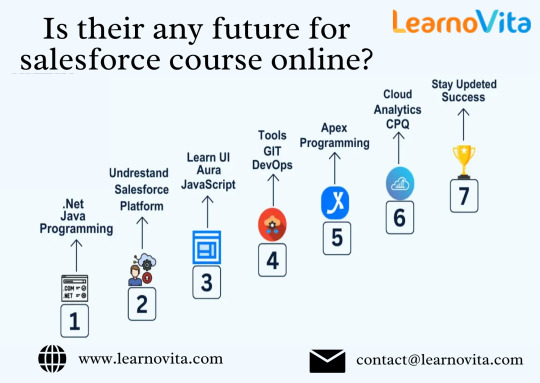
5. Continuous Learning in a Dynamic Ecosystem
Salesforce evolves rapidly, with regular updates and new features introduced multiple times a year. Online courses help learners stay updated with these changes, ensuring they remain relevant in the competitive job market. With topics like Salesforce Einstein (AI capabilities) and industry-specific solutions, online platforms equip professionals with cutting-edge skills.
6. Cost-Effectiveness and Diverse Options
Compared to traditional classroom training, online Salesforce courses are more affordable and widely available. Learners can choose from free tutorials, subscription-based platforms, or premium programs based on their budgets and learning needs. This democratizes access to high-quality education, making Salesforce expertise attainable for all.
7. Networking and Community Support
Salesforce has a vast and active community of professionals and enthusiasts. Many online courses provide access to forums, webinars, and group discussions, fostering collaboration and networking. Engaging with this community offers valuable insights, mentorship, and career growth opportunities.
8. Remote Work and the Digital Shift
The global shift toward remote work has increased the reliance on cloud-based solutions like Salesforce. This trend has also fueled the demand for professionals who can implement and manage Salesforce systems remotely. Online learning aligns perfectly with this digital transformation, equipping learners with the skills needed for remote roles.
9. Expanding Career Opportunities
Salesforce’s ecosystem continues to expand, creating diverse career opportunities across industries. From healthcare and finance to retail and technology, Salesforce professionals are needed in every sector. Online training allows learners to specialize in specific Salesforce applications, ensuring they can target roles that align with their interests and strengths.
Conclusion
The future of Salesforce learning lies in online courses. With their flexibility, affordability, and ability to stay updated with the latest trends, they are the ideal solution for anyone looking to enter or advance in the Salesforce ecosystem. Whether you’re a beginner exploring career opportunities or a professional aiming to upskill, online Salesforce courses provide the knowledge and certifications needed to succeed in this dynamic and rewarding field.
Investing in Salesforce training today means securing a future in one of the fastest-growing domains in the tech industry. With endless possibilities and evolving opportunities, the path to a successful Salesforce career starts with online learning.
0 notes
Text
Learn Salesforce: Your Guide to Mastering the #1 CRM Platform

Salesforce is the world’s leading Customer Relationship Management (CRM) platform, empowering businesses to streamline their processes, boost productivity, and foster meaningful customer relationships. Whether you’re looking to break into the tech industry or enhance your existing skills, learning Salesforce offers numerous benefits. With its extensive use across industries, Salesforce proficiency can elevate your career trajectory and make you a highly desirable candidate in the job market.
Why Learn Salesforce?
The demand for Salesforce professionals is skyrocketing due to its widespread adoption. By understanding Salesforce, you’re setting yourself up to access lucrative job opportunities in roles such as Salesforce Administrator, Salesforce Developer, Salesforce Consultant, and Salesforce Architect. Let’s look at the core benefits of diving into the Salesforce ecosystem:
High-Demand Skills: Salesforce skills are highly sought after by companies globally.
Career Growth Opportunities: From entry-level to advanced roles, Salesforce expertise can lead to progressive career paths.
Flexible Job Market: Salesforce skills apply to multiple industries, from technology and finance to healthcare and retail.
Remote Work Potential: Many Salesforce roles offer remote working options, making it an attractive choice for work-life balance.
Top Searches Related to "Learn Salesforce"
The following keywords align with low keyword difficulty and high search volume, making them ideal for an SEO strategy focused on organic growth:
Salesforce for Beginners
Salesforce Administrator Certification
Salesforce Developer Training
Salesforce CRM Tutorial
Salesforce Lightning Training
Getting Started: Core Components of Salesforce
To learn Salesforce effectively, it's essential to understand its core components and modules, each offering unique functionalities.
Salesforce Sales Cloud: Aids in managing sales processes, tracking customer data, and automating tasks.
Service Cloud: Designed to enhance customer service, helping businesses provide personalized support.
Marketing Cloud: Focuses on marketing automation, customer journey mapping, and creating personalized marketing campaigns.
Salesforce Lightning: The latest UI that offers a modern and streamlined experience for users and administrators alike.
These components make Salesforce a comprehensive solution for customer relationship management, adaptable for diverse business needs.
Step-by-Step Guide to Learn Salesforce
Here is a clear path for beginners to learn Salesforce effectively:
Step 1: Familiarize Yourself with Salesforce Basics
As with any new software, start by exploring Salesforce’s user interface. Salesforce provides extensive learning materials, often accessible through Salesforce Trailhead, its official learning platform. Salesforce Trailhead is a free, gamified online platform where users can earn badges and learn at their own pace.
Step 2: Start with Salesforce Administrator Training
Salesforce Administrator Certification is often the starting point for Salesforce beginners. This certification provides foundational knowledge of the platform, including how to manage user data, security, and customization settings. Some popular topics covered in administrator training include:
User Management: Setting up user permissions, profiles, and roles.
Data Management: Configuring data models, object relationships, and data validation.
Security: Understanding profile-based permissions and role hierarchies.
Step 3: Learn Salesforce Development Skills
Once you’re comfortable with administrative functions, learning Salesforce Development is an excellent next step. Salesforce Developers work with Apex (Salesforce’s proprietary language) and Visualforce to create custom applications, workflows, and automated processes. Key areas to focus on for development include:
Apex Coding: Used for building custom logic and automation on the platform.
Visualforce and Lightning Components: Used for customizing user interfaces.
SOQL (Salesforce Object Query Language): Enables querying data stored within Salesforce.
Step 4: Explore Advanced Modules Like Salesforce Lightning
Salesforce Lightning is the platform’s advanced, highly responsive user interface. Learning Salesforce Lightning development will allow you to build interactive applications and components, enhancing your proficiency as a developer or consultant.
Step 5: Take the Salesforce Certification Exams
For each specialization—whether Salesforce Administrator, Salesforce Developer, or Salesforce Consultant—there are certification exams available. Holding certifications can significantly boost your resume, especially for competitive job positions.
Top Courses to Learn Salesforce
To help with your Salesforce learning journey, here are some recommended courses and resources that cover essential skills and prepare you for certification exams:
Salesforce Administrator Certification Prep: Aimed at beginners, this course covers fundamental topics and exam preparation.
Salesforce Development Masterclass: Dive into advanced Salesforce development topics, including Apex, Visualforce, and Lightning Components.
Salesforce Marketing Cloud Training: Designed for marketers who want to leverage Salesforce for building customer engagement campaigns.
Career Pathways in Salesforce
Salesforce Administrator: Manage user permissions, handle data, and maintain system integrity.
Salesforce Developer: Build and maintain custom applications on Salesforce using Apex and Visualforce.
Salesforce Consultant: Work with clients to understand their CRM needs and provide customized Salesforce solutions.
Salesforce Architect: Oversee complex Salesforce implementations, focusing on integration and scalable solutions.
Each role offers a unique set of challenges and benefits, making Salesforce a flexible career path.
Best Practices to Master Salesforce
Utilize Salesforce Trailhead: Salesforce’s free online learning platform offers structured paths for all levels.
Network with Other Salesforce Professionals: Joining groups like Salesforce Ohana helps in learning from others and staying updated on trends.
Hands-On Practice: Practice is essential to mastering Salesforce concepts. Many platforms offer Salesforce sandbox environments for real-world practice without affecting live data.
Stay Updated: Salesforce constantly updates its features, so staying informed on new updates is key.
Industry Applications of Salesforce
Salesforce skills are applicable across various industries:
Healthcare: Used for patient data management and service customization.
Retail: Assists in personalizing customer journeys and managing loyalty programs.
Financial Services: Facilitates relationship management and provides analytics for decision-making.
Nonprofits: Manages donor relations, streamlining donation tracking and volunteer management.
Preparing for Salesforce Certification Exams
Certification exams can be challenging, so structured preparation is crucial. Salesforce offers resources and practice tests for each certification. Some tips for effective preparation include:
Allocate Study Time: Salesforce certifications cover vast material, so consistent study sessions are essential.
Utilize Study Guides: Use official Salesforce study guides for structured preparation.
Take Practice Exams: Taking practice exams can help you get comfortable with the exam format and question types.
FAQs on Learning Salesforce
Q: How long does it take to learn Salesforce?
A: Depending on your schedule, it typically takes 1-3 months to gain a foundational understanding of Salesforce and prepare for the Salesforce Administrator certification.
Q: Is coding required to learn Salesforce?
A: No coding is required for Salesforce Administrator roles, but development roles require knowledge of Apex, Visualforce, and SOQL.
Q: Can I learn Salesforce for free?
A: Yes, Salesforce Trailhead offers free courses covering a range of topics from beginner to advanced levels.
Q: Which Salesforce certification is best for beginners?
A: The Salesforce Administrator Certification is ideal for beginners as it covers the platform’s fundamental aspects.
Conclusion: Your Salesforce Learning Journey Awaits
Embarking on your journey to Learn Salesforce can open doors to numerous career opportunities. With dedication, hands-on practice, and structured learning, you can master Salesforce and secure a valuable role in today’s tech landscape.
0 notes
Text
what is Salesforce?
In today’s fast-paced business landscape, Customer Relationship Management (CRM) systems are indispensable for optimizing customer interactions and operational workflows. Among these platforms, Salesforce stands out as a robust cloud-based solution that empowers businesses across various sectors to streamline sales, marketing, and customer service processes effectively. Delving into Salesforce through dedicated courses not only enhances professional expertise but also opens doors to lucrative career opportunities in fields like healthcare, finance, and beyond.

Why Choose a Salesforce Course?
Career Advancement: Salesforce certifications significantly enhance career prospects by providing specialized knowledge tailored to roles in sales, marketing, customer service, and more.
Hands-on Learning: Courses typically include practical exercises and projects that simulate real-world scenarios, equipping learners with essential skills in customizing Salesforce, automating workflows, and analyzing data effectively.

Comprehensive Curriculum: Salesforce courses cover a broad spectrum of topics, ranging from fundamental navigation and data management to advanced functionalities such as AI-driven analytics and application development.
Community and Support: Enrolling in a Salesforce course connects you with a vibrant community of users and developers, offering access to expert instructors, peer networks, and ongoing resources for continuous learning and professional growth.
Types of Salesforce Courses Administrator Courses:
Foundational training focused on configuring and managing Salesforce applications, users, and data, ideal for those overseeing Salesforce implementation within organizations.
Developer Courses: Aimed at individuals interested in customizing Salesforce through coding, covering languages like Apex and Lightning Component Framework for building robust applications.
Sales and Service Cloud Courses: Tailored for sales and customer service teams, emphasizing lead management, opportunity tracking, case management, and service automation using Salesforce.
Marketing Cloud Courses: Explore creating personalized marketing campaigns, managing customer journeys, and analyzing campaign performance using Salesforce Marketing Cloud’s tools and capabilities.
Advanced Courses: Specialized training on topics such as Salesforce Einstein (AI), system integration, and Salesforce Lightning Experience, enhancing user interface and operational efficiency.
Investing in Salesforce courses not only enhances technical proficiency but also positions professionals at the forefront of CRM innovation. Whether aspiring to become a Salesforce administrator, developer, consultant, or marketer, these courses offer tailored paths to success in leveraging Salesforce’s full potential.
Embrace the world of Salesforce today and explore online courses, tutorials, or certification programs that align with your career goals. By mastering Salesforce, you not only advance your career but also contribute to driving organizational success through technological empowerment.
In summary, Salesforce courses empower professionals to unlock the full potential of this leading CRM platform, fostering efficiency, innovation, and growth across global enterprises. Whether starting out or advancing in your career journey, mastering Salesforce is a strategic investment with enduring rewards.
1 note
·
View note
Text
Boomi Guide

Boomi: Your Guide to Effortless Integration
What is Boomi?
Boomi (Dell Boomi) is a cloud-based integration platform as a service (iPaaS). It simplifies connecting different applications, databases, and systems in the cloud or on-premises.
Think of Boomi as a digital bridge-builder, seamlessly making your various software systems “talk” to each other.
Why Use Boomi?
Speed: Boomi’s drag-and-drop interface and library of pre-built connectors let you set up integrations lightning-fast.
Agility: Easily modify integrations as your business needs change without complex coding.
Scalability: Boomi grows with your business, making it ideal for organizations of all sizes.
Reliability: Enjoy a robust platform with minimal downtime and regular updates.
Cost-Effectiveness: Boomi’s flexible pricing models often mean long-term savings compared to manual integration efforts.
Common Boomi Use Cases
Cloud Integration: Connect your favorite SaaS apps like Salesforce, NetSuite, Workday, and more.
Hybrid Integration: Bridge your cloud-based systems with legacy, on-premises applications.
B2B Integration: Streamline communication and data exchange with partners and suppliers.
API Management: Create, publish, and secure APIs to unlock new business opportunities.
Master Data Management (MDM): Ensure data consistency and quality across your enterprise.
Boomi Basics for Beginners
Connectors: Pre-built components that enable communication with specific applications and technologies.
Processes: The integration workflows you design in Boomi. They consist of shapes (explained below).
Shapes: The building blocks of Boomi processes – Start, Data Process, Connector, Flow Control, etc.
Deployments: Executing your Boomi processes in a runtime environment (called an Atom).
Tips for Getting Started
Start Small: Begin with a simple integration project to get a feel for the platform.
Leverage the Boomi Community: The active community is a phenomenal resource with tutorials, forums, and experts.
Training: Consider Boomi training courses to accelerate your learning.
Best Practices: Familiarize yourself with Boomi’s design patterns and guidelines for optimal results.
The Power in Simplicity
Boomi democratizes integration, making it accessible to businesses of all sizes. If you need to streamline data flow, break down silos, and make your technology investments work harder for you, Boomi might be the perfect tool.
youtube
You can find more information about Dell Boomi in this Dell Boomi Link
Conclusion:
Unogeeks is the No.1 IT Training Institute for Dell Boomi Training. Anyone Disagree? Please drop in a comment
You can check out our other latest blogs on Dell Boomi here – Dell Boomi Blogs
You can check out our Best In Class Dell Boomi Details here – Dell Boomi Training
Follow & Connect with us:
———————————-
For Training inquiries:
Call/Whatsapp: +91 73960 33555
Mail us at: [email protected]
Our Website ➜ https://unogeeks.com
Follow us:
Instagram: https://www.instagram.com/unogeeks
Facebook: https://www.facebook.com/UnogeeksSoftwareTrainingInstitute
Twitter: https://twitter.com/unogeek
0 notes
Text
Enabling CSV data uploads via a Salesforce Screen Flow
This is a tutorial for how to build a Salesforce Screen Flow that leverages this CSV to records lightning web component to facilitate importing data from another system via an export-import process.
My colleague Molly Mangan developed the plan for deploying this to handle nonprofit organization CRM import operations, and she delegated a client buildout to me. I’ve built a few iterations since.
I prefer utilizing a custom object as the import target for this Flow. You can choose to upload data to any standard or custom object, but an important caveat with the upload LWC component is that the column headers in the uploaded CSV file have to match the API names of corresponding fields on the object. Using a custom object enables creating field names that exactly match what comes out of the upstream system. My goal is to enable a user process that requires zero edits, just simply download a file from one system and upload it to another.
The logic can be as sophisticated as you need. The following is a relatively simple example built to transfer data from Memberpress to Salesforce. It enables users to upload a list that the Flow then parses to find or create matching contacts.
Flow walkthrough
To build this Flow, you have to first install the UnofficialSF package and build your custom object.
The Welcome screen greets users with a simple interface inviting them to upload a file or view instructions.

Toggling on the instructions exposes a text block with a screenshot that illustrates where to click in Memberpress to download the member file.
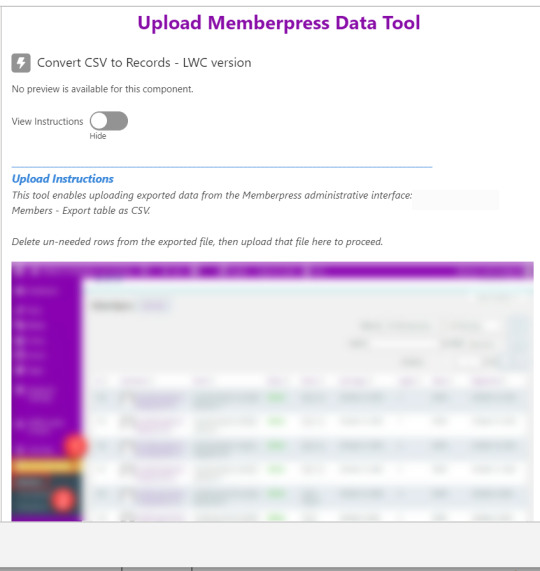
Note that the LWC component’s Auto Navigate Next option utilizes a Constant called Var_True, which is set to the Boolean value True. It’s a known issue that just typing in “True” doesn’t work here. With this setting enabled, a user is automatically advanced to the next screen upon uploading their file.
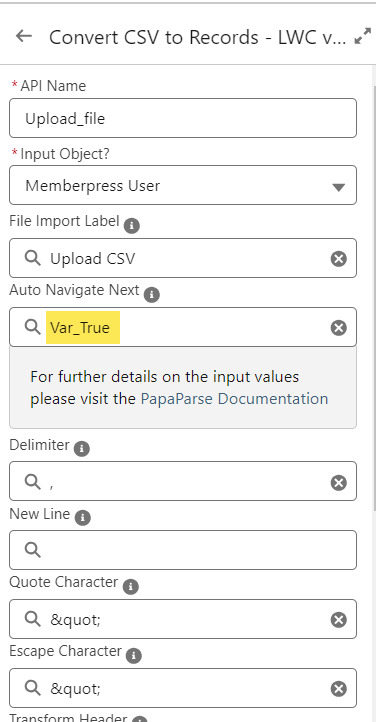
On the screen following the file upload, a Data Table component shows a preview of up to 1,500 records from the uploaded CSV file. After the user confirms that the data looks right, they click Next to continue.
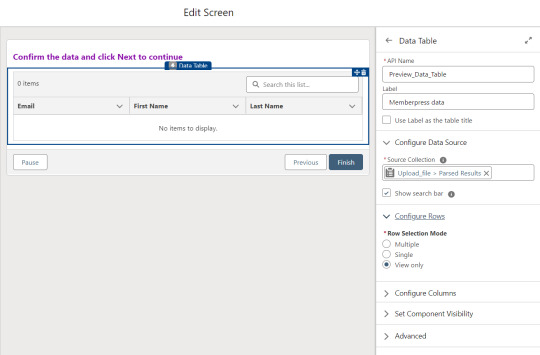
Before entering the first loop, there’s an Assignment step to set the CountRows variable.

Here’s how the Flow looks so far..

With the CSV data now uploaded and confirmed, it’s time to start looping through the rows.
Because I’ve learned that a CSV file can sometimes unintentionally include some problematic blank rows, the first step after starting the loop is to check for a blank value in a required field. If username is null then the row is blank and it skips to the next row.

The next step is another decision which implements a neat trick that Molly devised. Each of our CSV rows will need to query the database and might need to write to the database, but the SOQL 100 governor limit seriously constrains how many can be processed at one time. Adding a pause to the Flow by displaying another screen to the user causes the transaction in progress to get committed and governor limits are reset. There’s a downside that your user will need to click Next to continue every 20 or 50 or so rows. It’s better than needing to instruct them to limit their upload size to no more than that number.

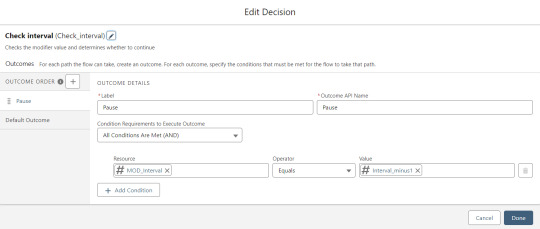
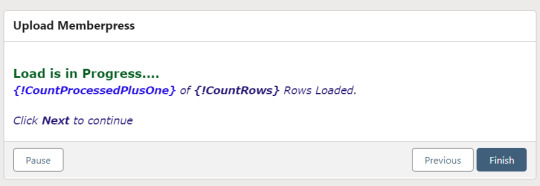
With those first two checks done, the Flow queries the Memberpress object looking for a matching User ID. If a match is found, the record has been uploaded before. The only possible change we’re worried about for existing records is the Memberships field, so that field gets updated on the record in the database. The Count_UsersFound variable is also incremented.

On the other side of the decision, if no Memberpress User record match is found then we go down the path of creating a new record, which starts with determining if there’s an existing Contact. A simple match on email address is queried, and Contact duplicate detection rules have been set to only Report (not Alert). If Alert is enabled and a duplicate matching rule gets triggered, then the Screen Flow will hit an error and stop.

If an existing Contact is found, then that Contact ID is written to the Related Contact field on the Memberpress User record and the Count_ContactsFound variable is incremented. If no Contact is found, then the Contact_Individual record variable is used to stage a new Contact record and the Count_ContactsNotFound variable is incremented.

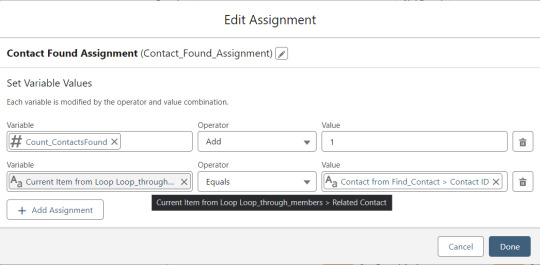

Contact_Individual is then added to the Contact_Collection record collection variable, the current Memberpress User record in the loop is added to the User_Collection record collection variable, and the Count_Processed variable is incremented.
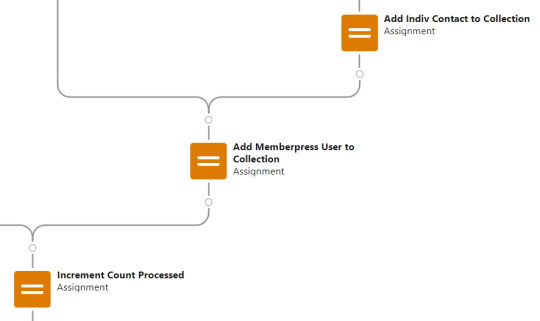


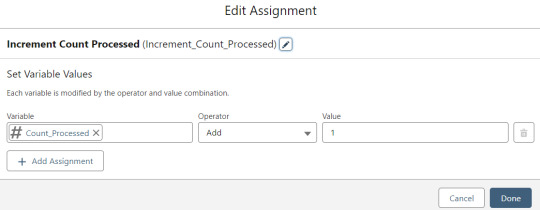
After the last uploaded row in the loop finishes, then the Flow is closed out by writing Contact_Collection and User_Collection to the database. Queueing up individuals into collections in this manner causes Salesforce to bulkify the write operations which helps avoid hitting governor limits. When the Flow is done, a success screen with some statistics is displayed.
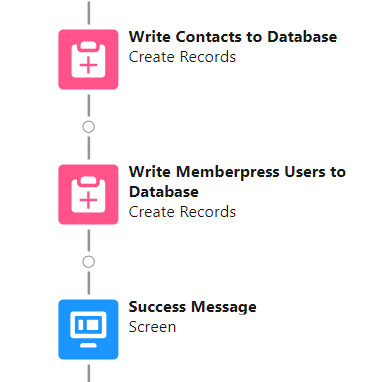

The entire Flow looks like this:
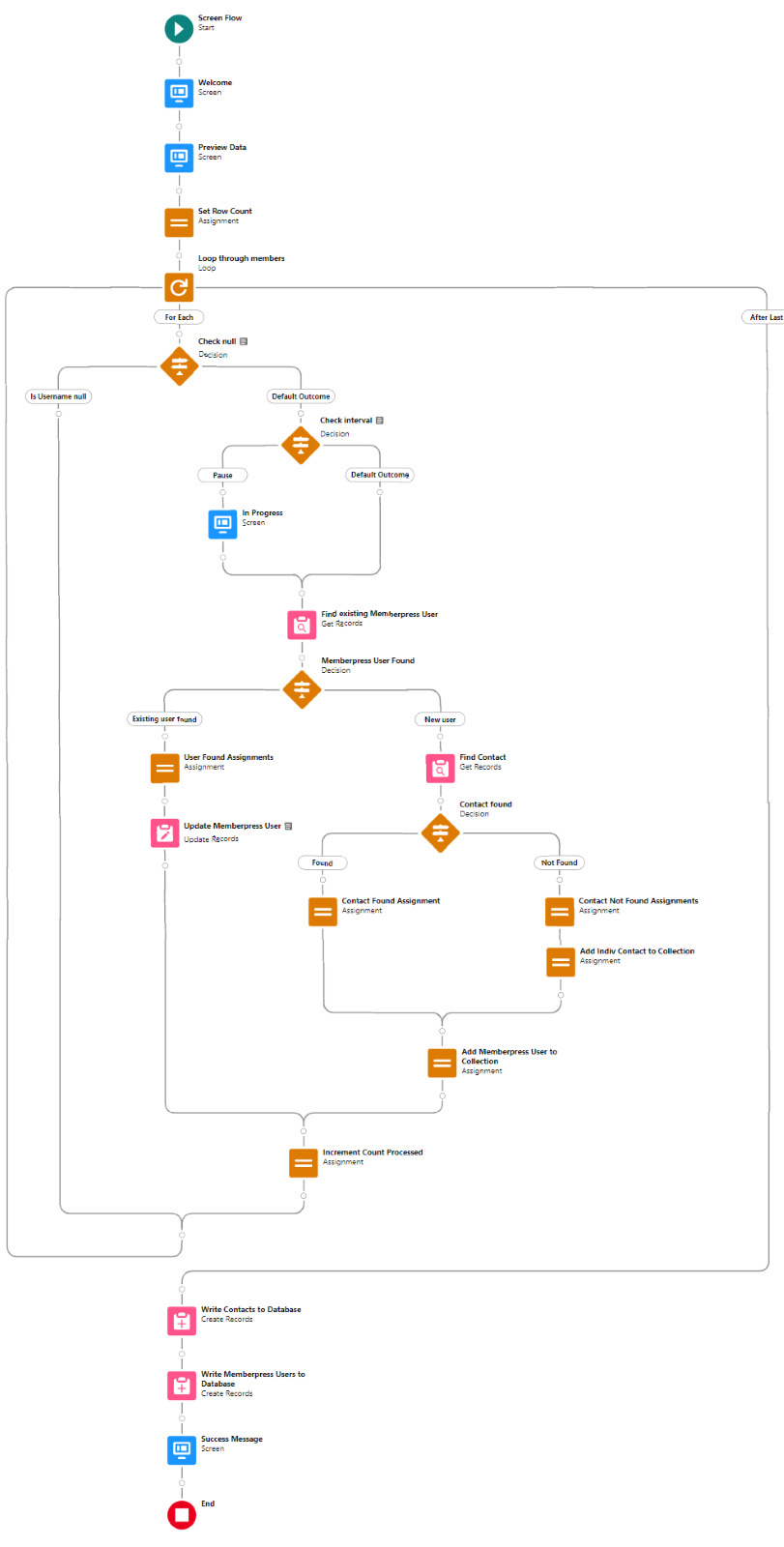
Flow variables
Interval_value determines the number of rows to process before pausing and prompting the user to click next to continue.
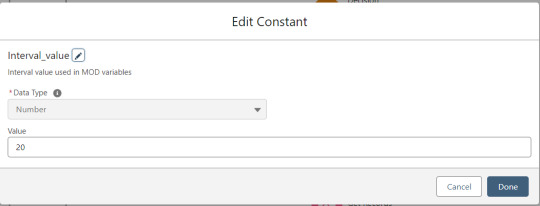
Interval_minus1 is Interval_value minus one.
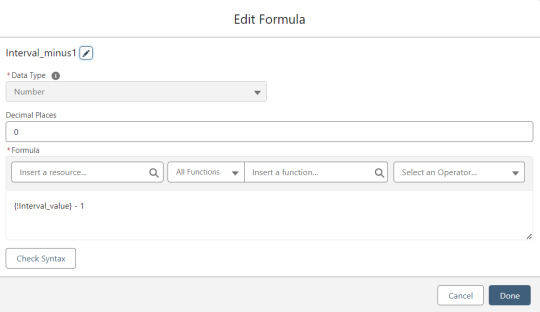
MOD_Interval is the MOD function applied to Count_Processed and Interval_value.

The Count_Processed variable is set to start at -1.

Supporting Flows
Sometimes one Flow just isn’t enough. In this case there are three additional record triggered Flows configured on the Memberpress User object to supplement Screen Flow data import operations.
One triggers on new Memberpress User records only when the Related Contact field is blank. A limitation of the way the Screen Flow batches new records into collections before writing them to the database is that there’s no way to link a new contact to a new Memberpress User. So instead when a new Memberpress User record is created with no Related Contact set, this Flow kicks in to find the Contact by matching email address. This Flow’s trigger order is set to 10 so that it runs first.
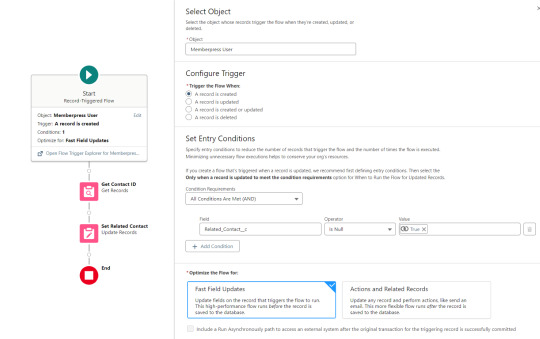
The next one triggers on any new Memberpress User record, reaching out to update the registration date and membership level fields on the Related Contact record

The last one triggers on updated Memberpress User records only when the memberships field has changed, reaching out to update the membership level field on the Related Contact record


0 notes
Text
Mastering Your Future: The Benefits of a Salesforce Development Course

Introduction:
In today's competitive job market, continuous learning and upskilling are vital for career growth. If you're considering a career in the world of Salesforce, enrolling in a Salesforce Development Course is a smart choice. This blog will explore the numerous benefits of investing in your education with a Salesforce Development Course. Whether you're a newcomer looking to break into the field or an experienced professional aiming to stay current, this course can be a game-changer for you.
Why Choose a Salesforce Development Course?
1. In-Demand Skills: Salesforce is a leading customer relationship management (CRM) platform, and the demand for skilled Salesforce Developers is on the rise. With a Salesforce Development Course, you'll acquire highly sought-after skills that can open doors to lucrative job opportunities.
2. Career Growth: Salesforce Developers play a crucial role in customizing, designing, and implementing solutions within the Salesforce ecosystem. As a result, they often enjoy rapid career progression and competitive salaries.
3. Comprehensive Learning: A well-structured Salesforce Development Course covers a wide range of topics, including Apex programming, Lightning components, and integration techniques. You'll gain a holistic understanding of Salesforce development, preparing you for diverse job roles.
4. Hands-On Experience: Many courses offer hands-on labs and projects, allowing you to apply what you learn in real-world scenarios. Practical experience is invaluable in the job market.
5. Certification Preparation: Salesforce offers various certifications for developers, and a dedicated course will prepare you for these exams. Earning a Salesforce Admin Certification Training can significantly boost your credibility and job prospects.
6. Stay Updated: The Salesforce platform evolves continuously. By enrolling in a Salesforce Development Course, you'll stay up-to-date with the latest features and best practices, ensuring you can provide the most innovative solutions to your future employers or clients.
7. Networking Opportunities: Courses often provide opportunities to connect with instructors and fellow students, creating valuable professional connections that can benefit your career.
Course Options
There are numerous options available when it comes to Salesforce Development Courses. You can choose from online courses, in-person classes, or a combination of both. Salesforce offers its own training through Trailhead, while various accredited institutions and online platforms provide comprehensive courses as well.
Online Courses: These are flexible and convenient, allowing you to learn at your own pace from anywhere in the world. They often include video tutorials, quizzes, and assignments.
In-Person Classes: If you prefer a more structured learning environment, you can find Salesforce Development Courses at local colleges or training centers. These provide in-person instruction and the opportunity for face-to-face interaction with instructors and peers.
Certification Courses: If your goal is to earn a specific Salesforce certification, look for courses designed to prepare you for the exam. These often provide focused, exam-centric training.
Bootcamps: Salesforce Development Bootcamps offer intensive, immersive learning experiences. They are typically shorter in duration but provide in-depth training.
Conclusion
Investing in a Salesforce Development Course is a strategic move for anyone looking to build a successful career in the CRM and Salesforce ecosystem. With the skills and knowledge gained from such a course, you'll be well-equipped to tackle the demands of this rapidly growing field and secure a promising future. So, why wait? Start your journey toward becoming a proficient Salesforce Developer today!
Are you prepared to advance in your professional life and earn your Salesforce Developer or Administrator certification? You've found it! Enrol in our Salesforce Training Institute to get the expertise you need to succeed in the Salesforce industry. Don't pass up this chance to improve your professional chances and maintain an advantage in the cutthroat employment market. Open up a world of opportunities by enrolling in our Salesforce courses right now.To learn more about LearNowX's courses and certification.
#Salesforce Development Course#Salesforce Training Institute#Salesforce Admin Certification Training
0 notes
Text
Salesforce Lightning component development certification

Why to learn Salesforce Lightning? In Salesforce lightning platform you build enterprise apps quickly that help you connect employees, engage customers, track performance, and integrate everything. This Platform is a single & unified ecosystem of tools & services, make it easier to build responsive applications for any device. It accelerate development and app performance, empowers admins to build Lightning pages, communities, visually, without code using Lightning templates and components.
Market demand for Salesforce lightning professionals? The demand for Salesforce skilled talent is HUGE… It’s time for you to get on action! The forecast for new jobs demanding Salesforce developer skill shows a huge increase from last year. Technical skills continue to be in high demand in today’s job market. Salesforce lightning developer roles now pay an average salary of $145k — that’s 27% higher than in 2018. Jobs that requires advanced technical skills, such as Visualforce, and lightning app builder. The bottom line is that Salesforce lightning developer skills lead to competitive salaries
Acquire new skills with our Salesforce lightning development certification We have team of experts for technology. They are familiar with technology culture. After completion of course, you will be able to
Create custom, reusable lightning components, and its applications.
Create Salesforce lightning components and applications
Expert understanding over Salesforce lightning ecosystem
Build an Salesforce application
Able to perform data validation & input forms
Good hands-on for Invite features
Good hands-on over SLDS and Lightning Tokens
Prerequisite This certification training course does not presume or require any prior knowledge or prerequisites. However, basic knowledge of salesforce concepts be an added advantageous. We are recommending that students should have following:
Basic programming skill
Basic knowledge of JavaScript, styling markup with CSS and HTML5
Experience in developing Salesforce applications
#salesforce lightning demo#salesforce lightning login#lightning tutorial salesforce#salesforce lightning#salesforce lightning tutorial
0 notes
Text
Internationalizing Your Lightning Web Component (LWC)
Internationalizing Your Lightning Web Component (LWC)
To state that everyone maintains at least one pet peeve is not an exaggeration. Years ago when I used to watch “That 70’s Show” I felt like the Red Foreman character was a bit over the top with his opinions, pet peeves, and things that seemed to irritate him without warning. Now, several decades later, the older version of me can relate to his pearls of wisdom. Well, one or two pearls,…

View On WordPress
#i18n#internationalization#lightning web components framework#salesforce admin & developer#tutorial#web design & development
0 notes
Text
How to develop Lightning DataTable for Salesforce flows
How to develop Lightning DataTable for Salesforce flows
Hello #Trailblazers, Welcome back to SFDCPanther and wish you a very happy new year 2022. In this blog post, we will learn how to develop a lightning datatable for Salesforce Lightning Flow Builder. We know that we can not directly develop the Lightning DataTable for Salesforce flow. So I have developed a lightning web component that can be used inside a flow and will work dynamically for any…
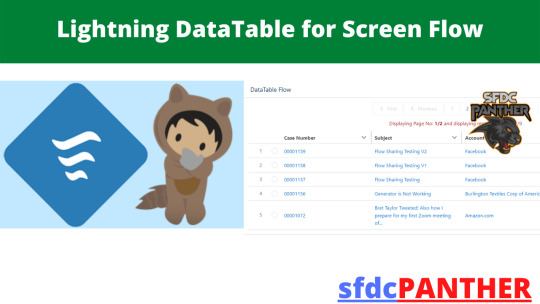
View On WordPress
#datatable for flow#Flow Builder#flow datatable#how to design for flow in sfdc#Salesforce#salesforce flow#salesforce flow datatable#salesforce flow tutorial#Salesforce Lightning
0 notes
Text
How to Invoke Apex class from Lightning web Component?
Call Apex Methods in Salesforce LWC- In this tutorial we are demonstrating a case study in which our experts explaining how to invoke apex class from one salesforce lightning web component to other. LWC can import method from Apex classes into the JavaScript classes after importing the apex class methods we can able to call apex class as functions into the components by either we can call wire service or Imperatively. The Apex method should be marked by aura component. Today's we will check in how many ways we can call Apex method from Lightning Web Components (LWC). Firstly, we need to import the Apex class and its method. Secondly, we need to make a method available to Lightning Web Component (LWC). For more details please watch our video tutorial and if you like to share and subscribe our channel for live updates. We the BISP have 100+ real time professional trainers share their technical and real time professional knowledge with the students and the customer satisfaction is 100%. If you are looking for online training and real time project training you are on the right track, please visit our website BISP Trainings and call +91 769-409-5404 or +1 386-279-6856.
#Update functionality lwc#implement Update functionality#Salesforce lightning web component#Salesforce online training#Salesforce lwc online training
1 note
·
View note
Text
Learn Salesforce Development 2023: a Comprehensive Guide

Salesforce is a leading player in today's fast-changing business environment. The robust set of tools and features that Salesforce offers,
Salesforce is the platform of choice for companies looking to streamline their operations and optimize customer interactions. Did you know that around 23% companies in the world use Salesforce?
If you're interested in a career with Salesforce training institute, then learning the development side of things would be a great choice. Prepare to begin a journey of mastering the art and science of Salesforce development.
This blog will help you learn how to develop effectively, whether you are a seasoned IT pro looking to enhance your skills or a Salesforce newbie.
You will be provided with a simple learning roadmap that covers the basics, certifications and future career options.
What is Salesforce Development ?
Let's first clarify what Salesforce Development is. Salesforce developers are experts who create and design custom applications for the Salesforce platform. These applications range from simple automation to complex industry-specific solutions.
Salesforce development is a specialization within the Salesforce domain. It focuses on customizing and expanding the Salesforce platform in order to meet specific business needs. It is the process of creating an application on the CRM platform that caters to specific business needs.
This process includes writing code using Salesforce's proprietary Apex programming language and using other tools such as Visualforce and Lightning Components to create custom solutions.
The development process begins after the business requirements are identified for CRM customization and personalization. This process ends with the application being delivered to customers. You can check out the following for more information on Salesforce development:
Learn Salesforce development
If you are interested in Salesforce development and want to make a career, we can help accelerate your journey. You can choose from a variety of routes to becoming an expert at developing applications. There are a few ways to reduce the time and learning required. Let's look at some of the best methods to learn about Salesforce development.
Learn Salesforce Hulk's Secrets with LearNowx
LearNowx is the first place to start. Shrey Sharma is the owner and founder of LearNowx, a Salesforce-training company. He has helped over 20,000 people launch their Salesforce careers with his free tutorials and training courses. These courses will help you master the basics of development and launch your Salesforce career by achieving Salesforce developer certification.
Candidates who are preparing to learn Salesforce development can access free tutorials on Salesforce platform development. This course covers fundamentals for Salesforce platform developer skills. It includes customizing Salesforce with a programmatic method, manipulating data using Apex including SOQL and SOSL, Apex Triggers and Apex Testing, as well as building custom UI using Lightning Components and Visualforce. This course also covers integration via APIs within Salesforce.
You can also take advantage of a premium training course, Salesforce Development Course. This course will help you pass the Salesforce Platform Developer I exam with ease. Candidates can learn from high-quality video lectures and have their questions answered in one-on-one discussions with instructors. These courses offer a personalized experience and the best developer training.
Trailhead
Trailhead is the second option to start learning Salesforce development. This is a great provider of online Salesforce Admin Certification Training courses. It is a great way to learn the basics of Salesforce development. This platform is built on three pillars: learning skills in demand, earning certifications that are worth a resume, and connecting with the global trailblazer community.
The modules also help users to learn programming in JavaScript, Apex, and Visualforce. These modules are also designed to help users learn programming languages such as JavaScript, Apex and Visualforce.
Trailhead is a gamification-focused platform, where developers can earn badges as they reach milestones on their learning journey. There are also interactive assessments to determine whether the learner understands the content.
Attend Salesforce training classes with an instructor
Instructor-led classes are the last option for learning development in Salesforce. The classes will require scheduling and coordination by the team, as opposed to the two previous methods that were unstructured and self-paced.
The instructors are experts in and Salesforce platform developer training.
The experts will interact with students one-on-one, ensuring that any doubts about concepts are clarified at the same. Salesforce beginners are encouraged to stay up-to-date with changes made in the Salesforce platform. The training courses are taught by instructors at LearNowx, ensuring that the maximum amount of learning is achieved.
These classes also include practical assignments, direct mentorship and support, as well as real-time projects. Instructors can help students achieve success by answering potential Salesforce developer interviews questions.
You can learn a lot about development quickly and easily by following these methods. There are also other options that offer limited support. Here are some of them:
Salesforce Developer documentation is the official Salesforce documentation
Online courses are available through platforms like Udemy and LinkedIn, as well as Pluralsight.
Websites such as Salesforce Stack Exchange, Salesforce Developer Community
Salesforce Developer Edition gives you the opportunity to get hands-on with Salesforce.
Attending Salesforce events like Dreamforce, Salesforce World Tour and local user meetings, with workshops on development topics
Books like Apex Programming for Salesforce Developers, Salesforce Platform Developer I Certification Guide, etc.
Browse Salesforce-related projects at GitHub
The Role of Salesforce Developers
Salesforce developers are professionals who oversee the deployment of Salesforce applications in businesses. As they manage Salesforce PaaS, these professionals are key to the development process. A Salesforce developer is responsible for jobs such as working with technologies like Visualforce, Apex and LWC. You need these Salesforce developer skills to ensure a smooth development process.
Salesforce developers who are familiar with the platform will have a better career.
A good command of languages, used in Salesforce such as Apex and Visualforce is required.
You will need to be able to build Lightning Components with Aura Framework and Lightning Web Components.
The development process is also built on a solid foundation of knowledge about the Salesforce integration process and its APIs.
Salesforce developer roles require you to be able to solve problems and use analytical skills.
You can learn more about the a Salesforce developer salary offers after becoming skilled and certified as a Platform developer. After becoming a certified Platform developer, you can find out more about the salary offered by Salesforce.
Conclusion
A rewarding and lucrative career can be found in Salesforce development course. You can achieve success by acquiring the required skills, earning the certifications and staying current with the latest features. No matter if you are a newbie coder or an experienced IT professional, your journey to mastering the development process begins with a commitment to learn and grow.
Explore the many resources, courses and communities that are available to you. Create custom solutions to transform your business. Learn, practice and enjoy the excitement of doing so. Stop thinking and start moving. You can start a journey of learning and passion in the Salesforce ecosystem if you have a strong desire to learn.
#Salesforce training institute#Salesforce development course#Salesforce Admin Certification Training
0 notes
Text
Building a Custom Salesforce Mobile App: A Step-by-Step Guide

For managing client data, sales procedures, and marketing activities, Salesforce is a potent platform. To fully realise Salesforce's potential, however, companies must create tailored mobile apps that let their sales and marketing employees access crucial information and interact while on the road. This blog post will offer a step-by-step tutorial for creating a unique Salesforce mobile app that suits your company's requirements.
Step 1: Determine the app's goals
Specifying the goals of the app is the first step in creating a bespoke Salesforce mobile application. What do you hope the app will accomplish? What should the app's primary features and functions be? What are the main user groups and what are they looking for? You can define the app's scope and establish a development roadmap with the aid of the answers to these questions.
Step 2: Design the User Interface
The user interface is a critical component of any mobile app, and it can make or break the user experience. When designing the user interface for your Salesforce mobile app, consider the following factors:
Keep the interface simple and intuitive.
Use a consistent design and color scheme.
Optimize for mobile screens and touch input.
Make sure the app is easy to navigate and use.
Test the interface with real users to get feedback and make improvements.
Step 3: Develop the App
With the app objectives and user interface design in place, it's time to start developing the app. Salesforce offers a range of development tools and frameworks, including the Lightning Component Framework, that make it easier to build custom mobile apps.
Here are the key steps in the development process:
Use the Salesforce Mobile SDK to create a new mobile app project.
Customize the app using the Lightning Component Framework and other tools.
Integrate the app with other Salesforce modules and third-party systems as needed.
Test the app thoroughly on different devices and platforms.
Refine the app based on user feedback and usage data.
Step 4: Deploy and maintain the app
It's time to release the app to users after it has been created and tested. Salesforce provides a number of ways to distribute customised mobile apps, such as through the AppExchange market or a mobile device management (MDM) programme.
It's crucial to maintain the app and make updates as necessary to make sure it continues to satisfy the demands of users and the company. This involves keeping track of user feedback and app performance, resolving bugs and other problems, and incorporating new features and functionalities as the company grows.
In conclusion, creating a custom Salesforce mobile app development can be a difficult process, but by using a step-by-step approach, businesses can make an app that satisfies their particular requirements and enhances productivity and cooperation and connect now Cloud Analogy.
0 notes